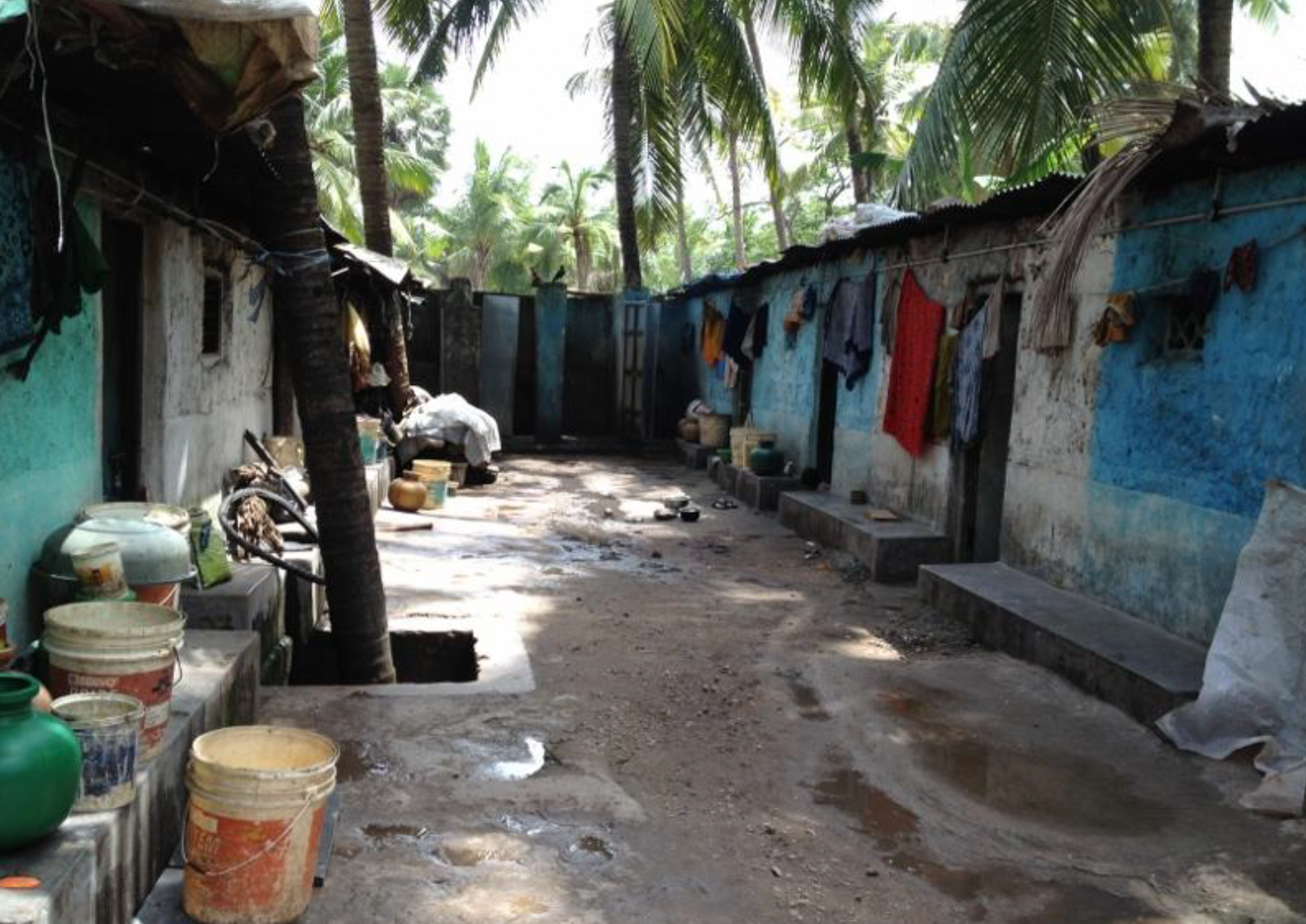Background
The entrepreneur who owns and operates the mini-grid system inherited the property from his father. The land is used as a plantation for coconuts, bananas, and other plants. Previously, the owner rented land to the plantation laborers who lived in makeshift tarpaulin tents. Due to a court order and community pressure, the owner was required to construct apartments for the resident laborers. Prior to installing the mini-grid system, residents would primarily use kerosene for light at a cost of 150-200 Rs per month. The kerosene was difficult to procure and posed health and safety risks. Residents would pay an additional 60-70 Rs per month for mobile charging.
Due to further community pressure, the owner decided to electrify the households. While grid power is available at the site, there were a number of drawbacks to using the grid. First, government agencies do not recognize the site as a formal settlement so there was a regulatory risk to installing grid electricity. Second, the electricity service in this area is not reliable. And finally, the electric service provider charges a minimum fee for each meter even if no power is consumed. As this housing is used by migrant day-laborers, the houses are not fully occupied year-round.
A solar system was suggested because of its capability to operate off-grid, its low operational costs, and its reliable power supply. Due to shading at the site, it was not feasible to install individual solar systems on each house. A solar minigrid is ideal for this property because the centralized photovoltaic system efficiently distributes power between the houses and the strong influence of the owner assures that monthly payments can be collected
Technological Solution
1.2 kW Solar PV panels with eight 200Ah batteries and a custom designed control system at 96VDC transmission. 60 houses have one 3W LED and mobile charger; 15 larger houses have two 3W LEDs, mobile charging, and power capacity for one 14W fan and one 30W TV.
The system powers two 3W LED streetlights and four 3W LED lights in the owner’s house.

Financial Solution
The owner financed the mini-grid system with a bank loan for Rs. 414,000 (US $69,000), from Canara bank which will be repaid over 5 years at 12% interest. The owner was already had a mortgage on the buildings from the bank. This is the first solar photovoltaic system that this bank branch has financed. Using the houses as collateral, the bank views this as a low-risk loan.Currently, the owner is charging all households a flat fee of Rs. 140 per month to recover his costs.
Key Aspects
Design challenges– The load specifications changed over the course of the project due to the landlord, which increased the cost and reduced the optimization of the system. During implementation, it was decided that the owner’s house would also be connected to the mini-grid, and although the system was designed to support a television in each of the 15 large houses, no houses currently use a TV.
Direct CurrentDistribution– SELCO designed a custom control system to support the 96 volt DC transmission network. Low voltage direct current reduces line losses and is efficient for powering lights and charging mobile phones.The larger houses designed to include fans and TVs will be connected to off-the-shelf 220 volt AC adapters.
Collection Mechanism– One of the key factors that made a centralized mini-grid feasible for this property is the fact that the owner of the system is already collecting rents form the electrified households. In this case, the owner can be assured to repay his loan for the system. Financing individual home solar systems for migrant day-laborers in rented housing would not have been possible.
Increase Efficiency– For this property, a mini-grid is more efficient than installing a number of decentralized home systems. Because of tree shade on the houses, installing individual solar panels on each house would not be practical. Further, because the mini-grid distributes electricity across all the houses from a single generation source, it is able to balance the varying loads across houses and efficiently distribute the power. This allows the solar photovoltaic array to be smaller compared to a collection of home systems.
Impact
Approximately 400 people benefit from the electrification of this community.
Savings: Residents save money on kerosene and mobile charging.
Wellbeing: Safety and health from avoiding kerosene; Safety from streetlights; increased comfort; and improved lifestyle
Project Nuances
Although available, grid electricity was ruled out because of expense to install meters, unreliability of service, and questionable legality of connecting an unrecognized settlement to the grid. A solar mini-grid is ideal because the individual houses are shaded and the owner is able to collect a monthly service fee from households along with rent.
Learnings
Maintenance Risk – While designing a customized system to fit the unique requirements of a customer may maximize the benefits, one drawback is that maintenance becomes more difficult. The local Clean Energy Enterprise branch has technicians which can fix basic issues like fuses or connections. The supplier, provides maintenance for the charge controller with a technician based in Mangalore. However, the 3-watt LED lights are not able to be repaired by a local partner. In the future, we will be sure to source parts that can be repaired locally by the Clean Energy Enterprise..
Rents – As noted above, one of the key factors that made a mini-grid feasible for this property is the fact that the owner of the system is already collecting rents from the electrified households. However, without individual metering there is a risk that residents will pay unequal shares for their energy consumption. Currently, the owner is charging one flat fee for each household regardless of the size of the house or its energy consumption.
